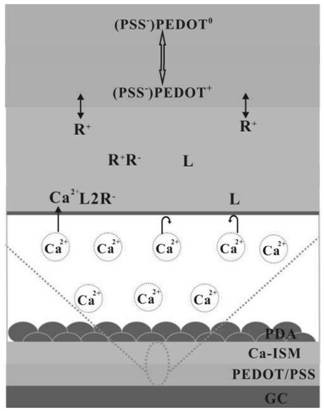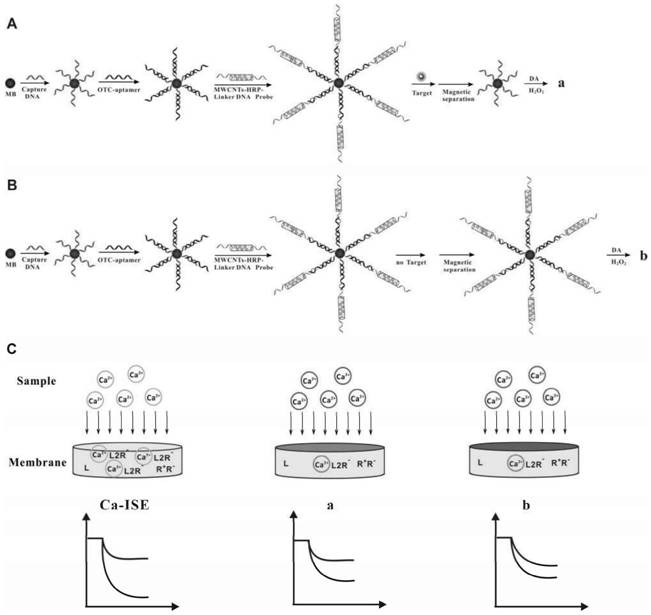A detection method based on polymer hindered sensitive membrane chronopotentiometry
A chronopotential and detection method technology, which is applied in measuring devices, material analysis through electromagnetic means, instruments, etc., can solve the problems of hindering sensitive membrane chronopotential, small ion flux, low sensitivity, etc., achieve high sensitivity and improve sensitivity , Versatile effect
- Summary
- Abstract
- Description
- Claims
- Application Information
AI Technical Summary
Problems solved by technology
Method used
Image
Examples
Embodiment 1
[0045] HRP not only catalyzes the polymerization of dopamine, but also acts as a polydopamine deposition anchor point to form a dense polydopamine film on the surface of the sensitive membrane, which effectively hinders the ion flux through the sensitive membrane phase under chronopotential conditions, thereby reducing the potential signal and improving the potential of the potentiometric sensor. sensitivity.
[0046] (1) Preparation of polymer membrane calcium ion selective electrode sensitive membrane: weigh 60 mg polyvinyl chloride, 120 mg o-nitrophenyloctyl ether, 20 mg inert lipophilic salt tetrakis(dodecyl)-tetrakis(4 -Chlorophenyl)ammonium borate (ETH 500) and 1.84mg of calcium ionophore II (ETH 129) were dissolved in 2 mL of tetrahydrofuran and stirred evenly to obtain a calcium ionomer sensitive membrane solution. The potential conducting layer is poly(3,4-ethylenedioxythiophene)-polystyrenesulfonic acid; poly(3,4-ethylenedioxythiophene)-polystyrenesulfonic acid solut...
Embodiment 2
[0051] Example 2 Detection of target object oxytetracycline
[0052] HRP and Linker DNA molecules are loaded on the carboxylated multi-walled carbon nanotube matrix to form a recognition probe with catalytic and bonding functions, and the nucleic acid aptamer of the target to be detected is used as the recognition molecule. The probe is combined with the nucleic acid aptamer on the magnetic bead by DNA hybridization, and the recognition molecule and the probe are immobilized on the magnetic bead. When no target is present, the probe is bound to the surface of the magnetic bead, and the dopamine and H 2 o 2Add it to the alkaline magnetic bead solution, and use a pipette to take an appropriate amount and drop it on the surface of the polymer sensitive membrane to react for a certain period of time. The HRP molecule on the probe can effectively catalyze the polymerization of dopamine on the surface of the polymer sensitive membrane to form a dense polydopamine film, which hinde...
Embodiment 3
[0062] Embodiment 3: Detection of target DNA
[0063] Loading HRP and Linker DNA molecules on the carboxylated multi-walled carbon nanotube matrix to form a recognition probe with catalytic and bonding functions to Escherichia coli ( E. coli -DNA) as the target. The target can be combined with the probe and the nucleotides on the magnetic beads through DNA hybridization to form a magnetic bead-target-probe complex. Combine dopamine and H 2 o 2 Add it to the alkaline magnetic bead solution, take a proper amount of it with a pipette and drop it on the surface of the polymer sensitive membrane to react for a certain period of time. The HRP molecules on the probe can effectively catalyze the polymerization of dopamine on the surface of the polymer sensitive membrane to form a dense layer of polymer Dopamine film, which blocks ion flux through the sensitive membrane phase under chronopotentiometry conditions, reduces the potentiometric signal. When no target is present, the pr...
PUM
 Login to View More
Login to View More Abstract
Description
Claims
Application Information
 Login to View More
Login to View More - R&D
- Intellectual Property
- Life Sciences
- Materials
- Tech Scout
- Unparalleled Data Quality
- Higher Quality Content
- 60% Fewer Hallucinations
Browse by: Latest US Patents, China's latest patents, Technical Efficacy Thesaurus, Application Domain, Technology Topic, Popular Technical Reports.
© 2025 PatSnap. All rights reserved.Legal|Privacy policy|Modern Slavery Act Transparency Statement|Sitemap|About US| Contact US: help@patsnap.com



